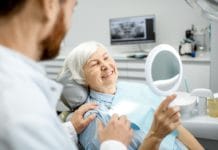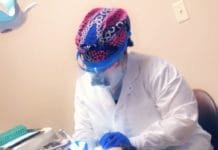In today’s society, many Americans are anxious or stressed. We live busy, on-the-go lifestyles and are constantly worrying while having less downtime to relax and mentally reset. Our bodies typically hold tension within the shoulders as well as the head and neck regions.
As dental professionals, we all know what bruxism is. Would it really be surprising to know the majority of our patients are probably clenching or grinding their teeth at some point or another? The question is, do we know the signs and symptoms to educate patients and help them seek necessary treatment?
What is Bruxism?
Bruxism by definition is:1
- An oral habit of grinding, clenching, or clamping the teeth
- Involuntary, rhythmic, or spasmodic movements outside the chewing range
- May cause damage to the teeth and attachment apparatus
Bruxism Symptoms
Signs and symptoms resulting from bruxism are related to the intensity of clenching and grinding.
- Clenching ‒ A forcible closure of the opposing dentition in a static relationship of the mandible to the maxilla.
- Grinding ‒ A forcible closure of the opposing dentition in a dynamic maxilla-mandibular relationship as the mandible moves through various excursive positions.
- Various signs and symptoms can include wear facets visible on enamel surfaces, abnormal rate of attrition and/or abfraction, increased masseter muscle tone or bulging masseters along the mandibular ridge, muscle tenderness, muscle fatigue, cheek biting, pain in the temporomandibular joint (TMJ), tori formation, tooth mobility, and pulpal sensitivity to cold.2,3
The heavy, repetitive motion of clenching and grinding can cause headaches, facial pain, neck and shoulder pain, loss of bone supporting the teeth, sensitive teeth, fractured teeth, ringing in the ears (tinnitus), and problems concerning the TMJ.1
Clenching and grinding apply force and pressure upon teeth, supporting bone, and the TMJ. Such force could be up to 250 pounds (1,700 kilopascals).4 Just think about that for a minute! How could that kind of force be applied continuously and not cause damage?
What are the Causes of Bruxism?
The cause of bruxism is still debatable. However, local factors such as occlusal interferences, combined with stress and tension, are considered contributing factors. Anxiety, hostility, and hyperactivity have all been linked with bruxism.2 Individuals suffering from sleep apnea and GERD are more prone to damage linked to bruxism.4
Sleep apnea is a large contributing factor, as many TMJD patients are also sleep apnea/airway patients. As dental professionals, we should be able to recognize the signs of airway distress, restricted velopharyngeal space, and tongue tie. Are you able to see your patient’s throat, or is it blocked by a long stretched uvula, enlarged tonsils, or macroglossia?3
Bruxism Clinical Signs
Attrition is typically a dead giveaway that bruxism is occurring, along with wear facets.2 However, the one clinical sign that dental professionals do not always consider is gingival recession.
Why not, though? Historically, gingival recession has been linked primarily to brushing too aggressively. This might be the case to some degree or in some cases. However, during my years in the clinical setting, I have observed that early signs of bruxism include slight, localized gingival recession and slight, localized attrition and/or wear facets present on the first molars and premolars.
As an individual continues to clench or grind their teeth, gingival recession and attrition become more severe and/or generalized over time. Clinicians should be aware of clinical signs as well as symptoms patients might exhibit in order to diagnose:5
- Hypertrophy of musculature, specifically of the masseters and temporalis muscles
- Attrition of the dentition
- Wear facets usually beginning in the first molars
- Gingival recession with or without abfraction
- Mobility of teeth
- Fractured teeth or fractures present in existing restorations
- Widening of the PDL present within radiographs
- Tenderness to palpation around masticatory muscles and TMJ
Clinical Consequences of Bruxism if Left Untreated
Continuation of attrition, recession, and abfraction due to bruxism can lead to:3
- Thermal hypersensitivity
- Hypermobility
- Injury around the periodontal ligament (PDL), which may later cause mobility
- Resorption of the alveolar ridge, especially in denture wearers who exhibit behavior of bruxism
- Fractures of tooth structure and/or restorations, idiopathic resorption at the CEJ, and tooth loss
Bruxism Treatment Options to Recommend
There are many reasons for bruxism to occur. Whether it be due to malocclusion, anxiety or stress, or sleep apnea and airway issues, oral appliances and night guards can be used to stop tooth-to-tooth contact and assist in stopping the progression of attrition/recession. The devices can also assist in decreasing headaches and/or pain within the TMJ as well as head and neck regions. Athletes and gym enthusiasts can protect their periodontium from bruxism during intense workouts.
Although the use of Botox has been historically controversial, recent studies have shown when Botox is injected into the masseter, medial pterygoid, and lateral pterygoid, it can decrease crepitus, pain, hyperactivity, and dysfunction.3,6 Because of such success, more dental professionals are recommending Botox for temporomandibular disorder treatment.
Individuals suffering from obstructive sleep apnea (OSA) can struggle to breathe at night, which not only affects their quality of sleep and life but also increases the risk for bruxism. An individual suffering from OSA will involuntarily attempt to increase oxygen flow, moving their lower mandible in hopes of opening their airway. These same individuals can voluntarily and involuntarily move into class 3 occlusion to open their airway during the day.3 Sleep studies should be considered as well for comprehensive diagnosis and treatment of bruxism.
Non-steroidal anti-inflammatory drugs (NSAIDs) can always be recommended to assist as an anti-inflammatory and pain relief. However, what does your patient’s overall diet look like? An anti-inflammatory diet, increasing the overall intake of fruits and vegetables, could naturally assist with overall inflammation within the body.
A study discovered that phytochemicals found within fruits and vegetables improve the metabolic profile by decreasing inflammation and blood lipid profiles.7 Personally, since adopting a paleo diet and increasing my intake of organic fruits and vegetables, I have no longer had chronic migraines or any other symptoms related to chronic inflammation.
Physical therapy, massage therapy, and chiropractic manipulation of the TMJ, as well as head and neck regions to release upper body tension, have historically been dismissed as TMD treatment. However, they are becoming more widely accepted as options. Also, studying and practicing myofunctional therapy among dental professionals is becoming more common. Myofunctional therapy can result in an improved airway when toning the infra- and suprahyoid.6 An improved airway can decrease the frequency and intensity of bruxism.
Personally, I began clenching during dental hygiene school. In 2014, I underwent a nasal open reduction surgery, in which my TMJ was hyperextended. I had severe bilateral popping, clicking, and pain, making eating extremely difficult. After chiropractic manipulations and massages, I was back to normal. Regular chiropractic manipulations and massages have continued to assist in the natural alignment of my spine and overall muscle relaxation, helping me decrease the frequency and intensity of clenching and thus decreasing TMJ pain or discomfort.
In Closing
We must know the signs and symptoms of bruxism to educate our patients and assist them in seeking necessary treatment. As dental professionals, it is our duty and responsibility to our patients to identify bruxism. Then, we must educate and assist them with appropriate treatment options.
Before you leave, check out the Today’s RDH self-study CE courses. All courses are peer-reviewed and non-sponsored to focus solely on high-quality education. Click here now.
Listen to the Today’s RDH Dental Hygiene Podcast Below:
Bruxism References
- Wilkins, E.M. (2004). Clinical Practice of the Dental Hygienist. (9th ed.). Jones and Bartlett Learning.
- Ibsen, O.A.C., Peters, S. (2022). Oral Pathology for the Dental Hygienist. (8th ed.). Saunders.
- Patricia Brinkman-Falter. (2022, October 10). Board Certified Orofacial Myologist. Nebraska Myofunctional Specialties.
- Hennessy, B.J. (2022, February). Teeth Grinding (Bruxism). Merck Manual Consumer Version. https://www.msdmanuals.com/home/mouth-and-dental-disorders/symptoms-of-oral-and-dental-disorders/teeth-grinding
- Aguilera, S.B., Brown, L., Perico, V.A. Aesthetic Treatment of Bruxism. The Journal of Clinical and Aesthetic Dermatology. 2017; 10(5): 49-55. https://www.ncbi.nlm.nih.gov/pmc/articles/PMC5479477/
- Ataran, R., Bahramian, A., Jamali, Z., et al. The Role of Botulinum Toxin A in Treatment of Temporomandibular Joint Disorders: A Review. Journal of Dentistry. 2017; 18(3): 157-164. https://www.ncbi.nlm.nih.gov/pmc/articles/PMC5634354/
- Williams, E.J., Baines, K.J., Berthon, B.S., Wood, L.G. Effects of Encapsulated Fruit and Vegetable Juice Concentrate on Obesity-Induced Systemic Inflammation: A Randomised Controlled Trial. 2017; 9(2): 116. http://mdpi.com/2072-6643/9/2/116












